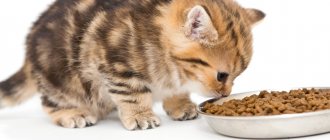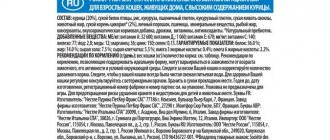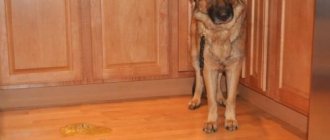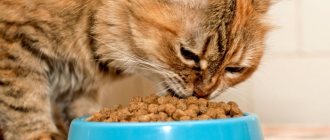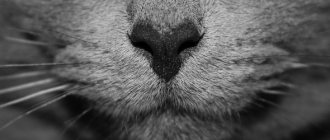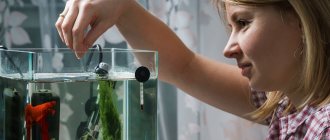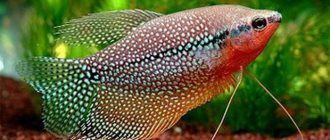Home › Aquarium fish ›
( 1 ratings, average: 5.00 out of 5)
Live food is the most natural food for omnivorous and carnivorous aquarium fish. Live food is especially useful in preparation for breeding and for the active healthy growth of fry. Live food will arouse much greater interest in the fish, causing them to show their hunting instincts and natural behavior.
Benefits of live food
- Modern dry, frozen, granulated food for aquarium fish is quite nutritious, contains vitamins, is varied, and provides everything you need. But live food contains more protein, vitamins and microelements.
- To produce offspring, some fish species must be fed only live food.
- The fry of all aquarium fish grow much faster when feeding on live food.
- Any packaged products, if they have not been eaten, remain in the aquarium, enter the filtration system, cloud the water and promote the growth of bacteria. Living organisms continue to live until they are eaten by fish.
- If you grow live food yourself, you can control the conditions for obtaining it. These products will not contain bacteria that can cause disease. Live food is an inexpensive way to provide fish with a healthy nutritional supplement. You can not only buy it ready-made, but also grow it yourself at home. Eggs or culture for this are sold in specialized stores.
Let's consider the types of live food that you can get yourself or purchase. They are arranged according to usefulness and nutritional value, from the best to the least nutritious and loved by fish.
What should you not feed your fish?
Very often there is information that bread, cookies, cheese, and egg products can be used as alternative food. However, this is a misconception; under no circumstances should they be fed to fish. The source of this information is old literature on aquarium husbandry, which is often copied by some printed publications and. It is possible that in earlier times, when the food chemical industry was not developed, such products could indeed be used, but at present this should not be done. The composition of modern food products is very extensive and a number of ingredients are potentially hazardous to the health of fish.
Another common misconception concerns carnivorous fish species, which are often offered pieces of beef, heart, liver and other offal of mammals and birds. This information also comes from outdated aquarium literature. Animal meat contains substances that are indigestible, which can lead to constipation and slow poisoning of the body. To be fair, it is worth noting that some predators, such as Piranhas and Trachira, as well as large catfish, are indeed capable of digesting this food, since in nature they periodically come across it, but they are rather the exception to the rule.
Artemia or sea shrimp
Artemia will undoubtedly take first place among live food for aquarium fish. All types of marine and freshwater fish eat it with pleasure; it is the most nutritious, rich in vitamins and microelements, and easily digestible.
Artemia is a genus of aquatic crustaceans that are found throughout the world and live in salt lakes. Artemia produce so-called dormant eggs, or cysts, which is why they have gained wide popularity in the aquarium hobby. Dried brine shrimp eggs have an incredibly long shelf life and can be used at any time to provide live, nutritious food for adult fish and fry.
Artemia nauplii (freshly hatched from crustacean eggs) are necessary food for the rapid growth of fry of any species of fish.
The eggs are placed in salted brine in any container (a glass jar, a jug, or even a plastic soda bottle, but it is recommended to use a container with a concave bottom) and filled with brine.
The brine is prepared using non-iodized salt: 1 tablespoon per liter of water. Some people use Epsom salt mixed with a pinch of baking soda.
The temperature is maintained at around 29 degrees Celsius and a light source needs to be placed above the container. Also, to obtain brine shrimp, be sure to use a compressor - it helps the crustaceans hatch and maintain life.
Once the nauplii hatch, they need to be collected for feeding. Turn off the air supply and let the water settle. The shrimp will settle to the bottom, and the remains of eggs and other debris will float to the surface. Artemia is collected from the bottom using a siphon or syringe.
Grown-up artemia can be fed with green algae, then it will acquire color and become more noticeable to fish.
Larger fish love large artemia, but at home it is almost impossible to grow it to adulthood, it is too troublesome. If desired, you can use a separate aquarium or even a swimming pool for this. To feed the crustaceans, green water and nutrients are added to the water. When the water turns yellowish-green, add crustaceans and wait for them to grow. The container must be fully or partially illuminated. You can add some brewer's yeast or micro-products to speed up growth.
Fasting days
Many aquarium inhabitants are prone to obesity. They can eat to such an extent that it even becomes difficult for them to move in space. For such gluttons, for example, goldfish, it is recommended to arrange fasting days once a week.
If the species does not suffer from obesity, then you can not completely deprive it of food, but simply refuse live food once a week and replace it only with plant food. For example, a dietary menu may consist of grated leaves of parsley, spirulina, nettle or seaweed.
This unloading allows you to cleanse your pet’s body, promote recovery processes and even increase sexual desire. It is important to arrange it for predators, but it would be good for scalars, apistogrammas and lapius to “sit” on a spirulina diet.
Next, watch a video with expert advice on how and what to feed aquarium fish.
Beginning aquarists very often overfeed their pets, which has negative consequences. This most often leads to water contamination, which can cause the death of the inhabitants of the aquarium or cause them to become stressed. The harmful consequences that arise boil down to the following aspects:
- Leftover uneaten food decomposes quickly, which causes the release of ammonia.
- Excess food, especially protein ingested by fish, contributes to increased release of ammonia into the water space with waste products. The resulting ammonia in the water can deplete the biological filter. However, the biological filter can adapt and will cope with the increased level of the substance for some time, but the end result will be contamination of the aquarium and the development of various parasites.
So, how often should you feed your aquarium fish? At one meal, they need to be given as much food as they can eat in approximately five minutes. If excess food gets in, it must be removed before decomposition begins in the water space.
A very large number of fish and fry in nature feed continuously, for this reason it is recommended to feed them several times a day in small portions. Maintaining a large aquarium with a variety of aquatic inhabitants will require feeding them 2-3 times a day. An exception to such feeding will be representatives of predatory fish, for which 2-3 meals a day will be enough for one week. When predators are full, they may ignore new food.
When maintaining an aquarium, it is worth considering the fact that some species are nocturnal, as they may skip feeding. It is necessary to very carefully monitor the behavior of the fish when receiving food and promptly respond to loss of appetite.
From the video you will learn how to prepare semolina porridge for fish.
Bloodworm
A well-known and widely available live food for aquarium fish, rich in protein (up to 60%). It ranks first in nutritional value among live fish food.
They appear to be small red worms, but are actually the larvae of non-biting aquatic mosquitoes or bell mosquitoes. Adults of these mosquitoes do not bite because their mouth parts are underdeveloped.
The bloodworm gets its bright red color thanks to an iron-binding protein, which is why the larvae are also called bloodworms. In nature, bloodworms can live in dirty water with low oxygen levels precisely thanks to this protein. And by feeding fish and shrimp such iron-rich foods, they get brighter, more saturated colors.
In nature, mosquito larvae live in bottom mud and feed on detritus and microorganisms.
Bloodworms are sold on sale in dry, freeze-dried, frozen and live forms. Of course, live food will be the most useful, especially during the period when fish are preparing for reproduction, but freeze-dried and frozen bloodworms are quite nutritious and healthy.
Live bloodworms do not last long. The life cycle of the larvae is quite short, only 10-12 days. Before feeding the fish, the larvae must be washed with clean water.
You can store bloodworms in the bottom of the refrigerator, damp, in a container. Usually the larvae are laid out on a damp sponge in a small container. Bloodworms need to be washed daily, removing dead larvae.
This type of live food is more suitable for large numbers of fish in large aquariums, since it is desirable that the entire portion be eaten within 2-3 days.
Collecting bloodworms in nature on your own is not recommended, as the risk of the larvae carrying infections and diseases is high. It is better to purchase a live product from a reputable breeder.
What do different types of fish eat?
Absolutely all fish differ from each other in the food they eat and their behavior during feeding. Predatory fish species can set up some kind of ambush when hunting their prey or freeze in anticipation of approaching prey. However, other predators may pursue their prey in the desire to overtake and capture the prey.
Herbivorous species primarily feed on living or decaying plant tissue. Aquarium fish get food by biting off parts of plants or can swallow them whole. However, among herbivorous fish there are species that eat only algae.
Herbivores
Herbivorous species have a long digestive tract. Its presence confirms the need for frequent feedings, but in small portions. The diet of such breeds when kept in a natural environment consists of various algae, particles of fruit, plants and seeds (Figure 5).
Figure 5. Feeding characteristics of herbivorous breeds
It is precisely because of physiological characteristics that you need to know exactly how many times a day to feed herbivores, depending on their type and size.
Carnivores
Carnivores have a characteristic large stomach, which indicates that food intake occurs in large quantities and infrequently (Figure 6). When kept in their natural habitat, carnivorous fish can feed on live or dead small animals, birds, insects, invertebrates and amphibians.
Figure 6. Features of feeding carnivorous aquarium fish
Omnivores
The name omnivore speaks for itself, since such species can eat both plants and live food. For each individual variety, it is necessary to select a separate food product, and in such matters qualified specialists in pet stores come to the rescue.
It is not recommended to make food yourself, as they may not be sufficiently saturated with the necessary substances for the life of aquatic inhabitants.
We suggest you read: Why does a cat shed and what to do about it?
Tubifex
Among hobbyists, Tubifex is considered one of the best foods for quickly raising fry, and it is also good for feeding adult fish, although it is considered not the best food due to its insufficient vitamin content and high fat content. In terms of nutritional value, it occupies the next place of honor after brine shrimp and bloodworms.
The tubifex is quite common, it can be easily found on sale and can be kept at home for a long time. There is an opinion that it is also possible to breed tubifex at home, but this is too labor-intensive a process that does not guarantee results.
The tubifex is a reddish worm up to 3-8 cm long. In nature, it lives in the muddy soil of reservoirs at shallow depths closer to the shore, where the silt is closer to the surface of the water. In such places, the water is sufficiently saturated with oxygen, and the worms are more protected from fish.
The fry are fed the smallest or chopped worms. Adult fish easily swallow the worm whole.
At home, worms can be stored for several weeks. For this you need a low tray. The acquired culture must be washed several times with dechlorinated water until it is clear. The washed worms are filled with water drained from the aquarium, the compressor tube is lowered into the tray and turned on. Store tubifex at room temperature.
After just 12 hours, the water in the tray becomes cloudy, and the tubifex culture is washed again. You need to repeat the procedure twice a day, and do not forget to use dechlorinated water, and after the procedure, turn on the aeration of the water.
Before feeding the fish, add 5 drops of acriflavine to a glass of clean water, and dip a selected batch of worms into this water for feeding. This is necessary in order to disinfect the tubifex and prevent the fish from becoming infected with possible diseases. Shake the worms and leave for 15 minutes to process. Then the solution is drained and the tubifex is washed with water until the worms are cleared of the solution. After this you can feed the fish.
Aulophorus (water snake)
Aulophorus are worms, close relatives of the tubifex. It is also found in freshwater bodies of water in temperate and tropical climates. This is a high-calorie food for raising fry. Not suitable for feeding large fish.
Aulophorus, unlike tubifex, is easy to breed at home. But there is a drawback - a very strong smell. To reduce the smell, the worms need to be washed regularly.
To breed aulophorus, lower the culture into a container filled with 5-10 cm of water and add mesh worm feeders with vegetables (carrots, zucchini, melon) or nettles. The worm is washed and fed daily. In a day you can get up to 300 grams of growth in a container of 20-25 liters. When breeding, it is advisable to use aeration.
Is it possible to feed aquarium fish with bread?
All aquarists know that each type of fish needs special food. However, aquarium pets need carbohydrates and proteins. To correctly compile a feeding diet, consultations with experienced sellers in pet stores are necessary.
When it gets into water, the bread gets wet very quickly and begins to sour, which causes unpleasant smelling water. It will be possible to get rid of such a smell only after completely replacing the water space of the aquarium. For this reason, using bread as fish food is not recommended.
Koretra
Coretra is also a mosquito larva, but it is a predatory larva. It feeds on microorganisms and can even attack fish.
Unlike bloodworms, coretra is transparent, and this is a big minus. Fish in water do not distinguish it well, and the larva can remain unnoticed for a long time, especially if the fish have poor vision due to their characteristics. And if the bloodworm immediately sinks to the bottom of the water, the coretra larva can float in the water column.
Koretra cannot be bred at home. Nutritionally, it is much less nutritious live food than bloodworms, and less attractive to fish.
How long can you not feed aquarium fish?
The need of aquarists for a summer vacation reflects a person’s natural desire to rest during the entire working year. However, during such periods the aquarium must be left unattended.
Note: A properly equipped aquarium can survive without human intervention for a certain period of time. Aquarium fish are very hardy creatures and can easily withstand a temporary lack of food.
Before leaving for a long period of time, you should not purchase new fish and plants (to avoid infection of the water area), fry and other small individuals. It is also worth reducing the dosage of food given and completely eliminating foods that pollute water from the diet. The fish will eat only the portion they need, and the remainder will begin to spoil the quality of the water. It is imperative to clean all aquarium equipment and refresh the water by replacing 1/3 of the total volume. It is not recommended to leave sick fish for a long time in a community aquarium.
Under such conditions, the fish can remain without feeding for 7-10 days, depending on the species.
Daphnia
Daphnia or water fleas (0.2-5 millimeters) are an ideal live food for adult fish, as many fish feed on them in their natural habitat. Daphnia easily survive in the aquarium, helping to clean it by eating microscopic food debris until they themselves are eaten. If you add them to a fry tank, they will clean the water by eating bacteria that can kill the fry while still being a source of food.
The downside is that not all types of fish eat daphnia.
The daphnia culture is placed in any suitable container and a light source is installed, natural solar or artificial. There should be a lot of light.
The compressor tube is lowered into the container and the temperature is maintained at 24 degrees Celsius. You can feed daphnia with dry yeast, soy flour, and green flowering water. A siphon is used to collect fleas for feeding.
How much and how often to feed the fish
The question is not as simple as it seems. The most common and generalized option is
2-3 times a day in an amount eaten in about 5 minutes.
However, there are many nuances associated with specific types of fish. For example, some herbivores feed almost continuously and need constant access to food. In their case, it is advisable to stimulate the growth of algae or place pieces of green vegetables and fruits at the bottom. Predators, on the contrary, feed rarely, but take in large amounts of food at one time. Behavioral traits also play a role. Some species are overly active during feeding and will not allow fish that are too timid and/or slow to approach the feeder. Others feed exclusively at night or at dusk, hiding in shelters during the day; therefore, for them, food must be served before turning off the lights.
When keeping fish with different feeding methods in the same aquarium, it is important to ensure that all pets receive the required portion of food. Otherwise, there is a high risk of malnutrition, which can ultimately lead to health problems or even death from exhaustion. Fortunately, there are many commercially available products to suit the dietary needs of all fish species. The main thing is to choose correctly.
Grindal worms
Grindal worms or microworms (commercially known as nematode microworms) are truly microscopic worms, they are smaller than newly hatched brine shrimp nauplii, so they are an ideal food for fry, but small fish will also happily eat them. Grindal grows up to 1-2 mm in length, the nutritional value is 10.1 g of protein and 19.5 g of fat per 100 g (the nutritional value is much lower than that of brine shrimp, bloodworms or tubifex).
The bottom of a small container is covered 1 cm with oatmeal. First, the flakes are mixed with water so that the mixture is thick enough. Yeast is sprinkled on top of the flakes and a grindal worm culture is added. One small spoon is enough to start growing microworms.
The container for growing the crop must be closed, but have holes for air to enter and moisture to escape. Store container at room temperature. The oatmeal will begin to smell yeasty and watery in a few days, and after a week you will be ready to harvest the grindal worms.
The crop can be stored and fed for several weeks before a fresh batch needs to be planted.
To collect grindal worms, the box must be placed in a warm place, for example, on a warm radiator or lamp. To escape the heat, the worms will begin to crawl up the side walls of the container.
About 15 minutes after the start of the procedure, the grindal can be collected by running a toothbrush or plastic knife along the walls of the container. The collected portion is washed into a jar of aquarium water, and then nematodes are collected from the bottom using a syringe and fed to the fish.
Grindal worms very quickly settle to the bottom and die there, so you need to feed the fry in small portions.
What to feed aquarium fish if there is no food
There are times in life when you suddenly run out of special food and you need to look for an urgent solution to the problem. However, there are ways to feed your pets by using the following tips (Figure 7):
- Earthworms: Large aquarium specimens are very willing to eat earthworms, but they must be thoroughly washed and crushed before dispensing. You should give the fish only the amount they need to completely satisfy their hunger.
- Raw meat without streaks of fat can be eaten in the absence of live food. Raw meat should be scraped off with a knife and given to aquarium pets only in this form.
- Cereals, especially buckwheat or semolina, as well as wheat porridge, are very readily eaten by all types of carp and labyrinth fish. However, such products should only be given as a last resort. The cereal must be boiled until it becomes a thick porridge, then rinsed under a stream of cold water and only after all the mucus has disappeared, strain through a sieve. You can store it in any cool place.
- Non-live food. This includes: dried daphnia, egg yolk, bloodworms (cut, dried and frozen), raw or dried meat, porridge, etc. Such feeds must be used with extreme caution, as they quickly decompose and begin to spoil the water.
Figure 7. Additional food for fish: 1 - earthworms, 2 - raw meat, 3 - semolina porridge, 4 - daphnia


